
The Bremen City Hall is the seat of the President of the Senate and Mayor of the Free Hanseatic City of Bremen. It is one of the most important examples of Brick Gothic and Weser Renaissance architecture in Europe. Since 1973, it is protected by the monument protection act. In July 2004, along with the Bremen Roland, the building was added to the list of UNESCO World Heritage Sites.
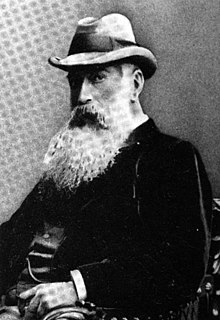
Johann Georg Poppe, often called Johannes Poppe by English-speaking writers, was a prominent architect in Bremen during the German Gründerzeit and an influential interior designer of ocean liners for Norddeutscher Lloyd. He worked in an eclectic mixture of historical revival styles sometimes called "Bremen Baroque".
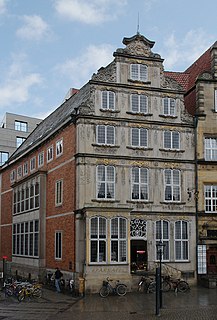
Haus der Stadtsparkasse is a Rococo landmark on the "Marktplatz" in Bremen, Germany. It was completed in the 1950s combining the historic front gable from another site with the more recent architecture of the remainder of the building.

The old Rathscafé, now named Deutsches Haus, is a listed building on the market place (Marktplatz) in Bremen, Germany. It is part of the monument ensemble No. 1–21.

The Bremer Marktplatz is a square situated in the centre of the Hanseatic City of Bremen, Germany. One of the oldest public squares in the city, it covers an area of 3,484 m2 (37,500 sq ft). It is no longer used as a market place except for the Christmas market and the annual Freimarkt Fair at the end of October.
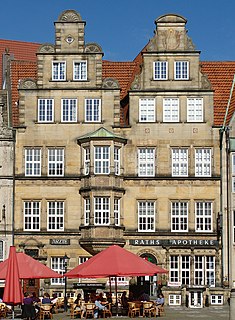
The Raths-Apotheke is a listed building on the Market Square (Marktplatz) in Bremen, Germany. After suffering war damage, the building was restored with two gables in the Neobaroque style in 1958, re-establishing the square's sequence of gabled buildings dating from the 1820s.
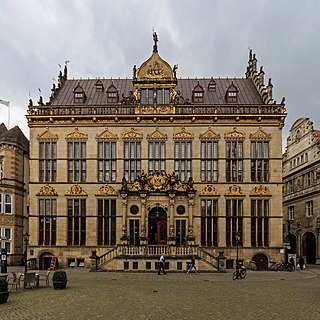
The Schütting, situated on the Marktplatz in Bremen, Germany, initially served the city's merchants and tradesmen as a guild house. In 1849, it became Bremen's chamber of commerce. Since 1973, it has been under monument protection. It lies on the south site of the Bremen marketplaces directly across from the town hall.

The Stadtwaage at No. 13 Langenstraße in Bremen (Germany) is the building in which the municipal weighing scales used to be housed. The facility was created in order to levy taxes and excise duties while protecting merchants and customers against fraud and dishonesty.

The New Town Hall has stood on the Domshof in the centre of Bremen, Germany since 1913. Located behind the Unser-Lieben-Frauen-Kirchhof cemetery, it is adjacent to the older section of the Town Hall with which it forms a harmonious ensemble. Among its sumptuous rooms decorated with local artefacts, the New Town Hall houses the Senate Chamber used by the Senate for its regular meetings and the Great Hall, a venue for official receptions. In 2004, Bremen Town Hall was listed as a UNESCO World Heritage Site, together with the Roland of Bremen.

Domsheide is a major square in the city of Bremen, Germany. It is located east of the Marktplatz and south of Bremen Cathedral. Streets leading to it include Ostertorstraße, Dechanatstraße, Balgebrückstraße and Violenstraße. It contains a number of important buildings, including the main post office, the courthouse, the cathedral precinct with the bell, and the annex to the stock market building. It is one of three main hubs of the public transport network, with most tram routes and two important bus lines crossing the square. The design of the Domsheide is relatively uneven, characterized by materials such as sandstone, dark red brick, red and yellow clinkers, render, concrete and marble.
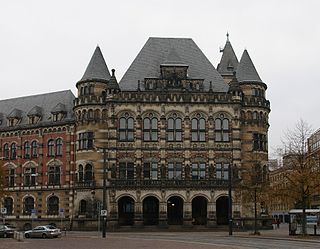
The Landgericht Bremen is located on the Domsheide in the old town of Bremen, Germany. It was built in the late 19th century in the French Renaissance style and completed in 1906. It has been a listed building since 1992. In addition to the judicial services of the regional court, the building houses sections of the Public Prosecutor's department (Staatsanwaltschaft) and of the district court (Amtsgericht).

The Kontorhaus am Markt in Bremen is a historical building in the city centre of Bremen, Germany. Today, it is used as a shopping mall. It is situated at the Bremer Marktplatz between three streets: Langenstrasse 2/8, Stintbruecke 1 and Bredenstrasse 13.
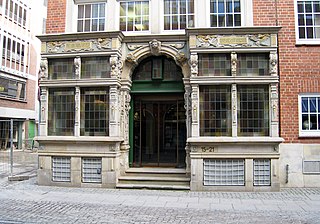
The Essighaus was an impressive gabled town house in the old town of Bremen in northern Germany. One of the city's finest examples of Renaissance architecture, it was almost completely destroyed by bombing in 1943. The entrance flanked by projecting bay windows is the only part of the building which has been restored.

The Bremen Main Post Office Building or is a Neo-Renaissance building in Bremen, Germany, that used to be the Imperial Post Office for the Bremen area. The building stands on the city square named Domsheide.

The Landherrnamt is a building in the Schnoor district of Bremen, Germany, which was designed by Alexander Schröder in the Neo-Romanesque style and completed in 1856.

Viertel is a centrally located neighborhood in the city of Bremen, Germany. It lies east of the old town on the border between two different administrative subdistricts: Ostertor and Steintor. Today it is known for its numerous cafés, restaurants, and boutique shops.

The Langenstraße is a historical street in the old town of Bremen in the north of Germany. First mentioned in 1234, it is one of Bremen's oldest streets and one of the most important for the city's merchants. It no doubt originated at the time when the first settlements grew up on the north bank of the Balge. It runs west from the Marktplatz parallel to the River Weser over Bürgermeister-Smidt-Straße to Geeren. Many of the street's historic buildings were seriously damaged during aerial bombings in the Second World War but were carefully reconstructed in the postwar period.
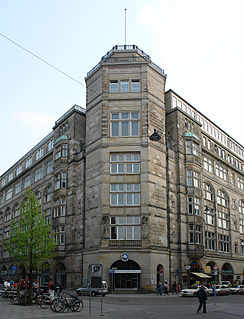
The Bremen Cotton Exchange was built in 1902 on the market square in Bremen, Germany, to house the offices of the city's cotton exchange founded in 1872. Johann Poppe's Neo-Renaissance facades and carefully finished interiors can still be seen today.

Gdańska Street is one of the main street of downtown Bydgoszcz, Poland. Initially, the street was a thoroughfare, but in the second half of the 19th century, it turned residential. It ran from the Brda river to Bydgoszcz northern part of town an has gradually become the city center of trade and entertainment. During the interwar period, Gdańska street was the third longest street in Bydgoszcz with a total length of 3.19 km.
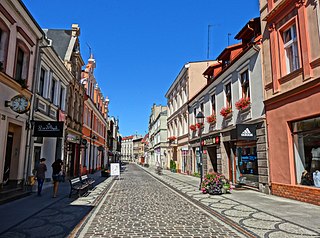
Długa Street is the longest street of Old Town district in Bydgoszcz and the most important historically. It stands next to Gdańska Street and Dworcowa Street as one of the most important avenues of downtown Bydgoszcz.




















